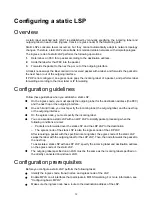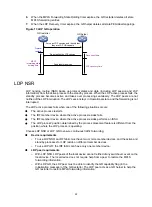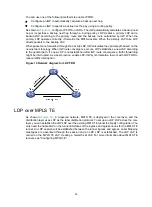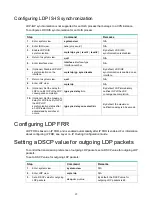
24
You can use one of the following methods to enable IP FRR:
•
Configure an IGP to automatically calculate a backup next hop.
•
Configure an IGP to specify a backup next hop by using a routing policy.
As shown in
, configure IP FRR on LSR A. The IGP automatically calculates a backup next
hop or it specifies a backup next hop through a routing policy. LDP creates a primary LSP and a
backup LSP according to the primary route and the backup route calculated by IGP. When the
primary LSP operates correctly, it forwards the MPLS packets. When the primary LSP fails, LDP
directs packets to the backup LSP.
When packets are forwarded through the backup LSP, IGP calculates the optimal path based on the
new network topology. When IGP route convergence occurs, LDP establishes a new LSP according
to the optimal path. If a new LSP is not established after IGP route convergence, traffic forwarding
might be interrupted. As a best practice, enable LDP-IGP synchronization to work with LDP FRR to
reduce traffic interruption.
Figure 14 Network diagram for LDP FRR
LDP over MPLS TE
, in a layered network, MPLS TE is deployed in the core layer, and the
distribution layer uses LDP as the label distribution protocol. To set up an LDP LSP across the core
layer, you can establish the LDP LSP over the existing MPLS TE tunnel to simplify configuration. You
only need to enable LDP on the tunnel interfaces of the ingress and egress nodes for the MPLS TE
tunnel. An LDP session will be established between the tunnel ingress and egress. Label Mapping
messages are advertised through the session and an LDP LSP is established. The LDP LSP is
carried on the MPLS TE LSP, creating a hierarchical LSP. For more information about MPLS TE
tunnels, see "Configuring MPLS TE."
















































